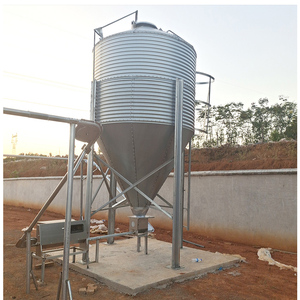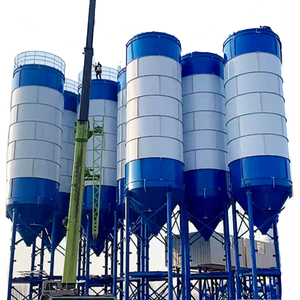(3136 products available)





















































































































































































































A silo is a storage structure usually used to store bulk materials like animal feed, grain, concrete, etc. It is predominant among farmers who store animal feeds and cereals for their livestock and for commercial purposes. Silos can store materials that will be released at once or continuously depending on specific conditions surrounding the materials. They are commonly made from steel, concrete, or aluminum. Silo shapes usually vary depending on the material used to construct them. Some common examples include the cylindrical silo and the conical silo.
Cylindrical silos
Cylindrical silos are commonly used to store agricultural products. They are built with galvanized steel sheets or plain steel. They are built with a circular cross-section and are usually fixed on the ground. The top portion of the cylindrical silo is usually bent inward, which protects it from unfavorable weather conditions like heavy rain. A normal cylindrical silo has an eaves and roof height that ranges from 4.5m to 20.4m.
Conical silos
Conical silos are typically used to store products that require a continuous flow, such as chemicals, cement, and agricultural grains. They are constructed with a cone-shaped bottom and a cylindrical midsection. This particular form aids in material discharge as a result of gravitational force.
Square (or rectangular) silos
Square silos are used to store cement, food products, and agricultural grains, among other things. They are built from steel or reinforced concrete. Compared to cylindrical silos, rectangular silos take up less space because they can be placed next to one another. They are, therefore, suitable for facilities with little space.
Bunkers
A storage facility with an open top and a rectangular or trapezoidal cross-section is called a bunker silo. The designs of bunker silos are usually made of reinforced concrete walls, piles of concrete blocks, or earth mounds. Compared from the other silos, the bunker silos are easily accessible. This enables quick filling and a continuous grain flow at a low cost. As a result, they are appropriate for large-scale agricultural operations and feed production businesses.
Horizontal Silos
The design of a horizontal silo, often known as a flat silo, resembles a mound of earth or flat building. The material is usually made of concrete, steel, or polyethene. To prevent the material from leaking, horizontal silos typically have a wall with a height of less than one meter. Materials that need to be stored for longer periods of time, such as cement, grains, and rock salt, are best suited for horizontal silos because they allow for storage in larger quantities.
All steel silos and grain bins require regular inspection inside and out by a qualified professional to ensure they are structurally sound. Their capacity is very high, which makes them ideal for grain storage. A 50 ton grain silo needs to be monitored for water leaks, rust inside and outside, and grain dust build up.
It's very important to maintain 50t silos, especially steel ones, to prevent fires or explosions from grain dust. The corrugated roof needs to be checked for water pooling or damp areas. Silos with several sections have more areas to inspect. Any water leaks and damp areas should be identified and fixed instantly. Pressure and temperature sensors should be used regularly to detect possible problems early and ensure the material is in good condition.
Silos are extremely useful in a variety of industries and make it easy to store materials in bulk. One of the most prominent industries that use these structures is agriculture. Farmers, as well as agriculture companies, use silos to store grains, corn, feed, and seeds. The ability to store these products makes it very convenient for farmers to save their goods for a rainy day or when the market prices for them are higher.
Construction is another industry where bulk material storage is required. Materials such as cement, sand, and gravel are often stored in silos because they are construction's bread and butter. Having these materials stored in 50t silos makes it easy for construction projects to flow seamlessly without any hiccups or delays caused by the absence of construction materials.
Industries that use chemicals also benefit from silos' convenience. Chemicals like ammonia, polyethylene, sulfur, and other chemical products can be stored safely in a silo. Chemical silos have the added feature of being resistant to chemicals, ensuring no reaction occurs between the silo and the chemical, affecting the chemical's quality.
The food industry employs silos to store large quantities of food items like sugar, flour, salt, and other feed ingredients used in the livestock industry. Keeping food items fresh can be quite a task, but silos offer the ideal solution thanks to their air-tight and humidity-tight storage capabilities, making them the perfect candidate for storing food items. They keep harmful insects and molds away from food, ensuring the food's quality is intact.
Those are just a few examples of how different industries use 50-ton silos to make their work more manageable and expedite their projects. If one were to look beyond these examples, one would find that many other industries also utilize silos for bulk material storage—industries like mining, wastewater treatment, energy, and even کہیں , بھی خواتین.
Some tips are helpful for selecting a suitable 50t silo. These tips apply to choosing any bin or silo for storing bulk materials. Business owners should always consider the material needs before anything else.
Firstly, know the type of material that needs storing. Different materials have unique characteristics. This may need specific requirements for the silo. For example, product permeability, flowability, and moisture content should all be considered. Consider the interaction between the material and the silo. This includes the potential for leaks or spoilage.
Next, determine the quantity of the material to store at any time. A 50t capacity silo may be ideal for a company that stores 50 tons of material monthly. However, ordering a silo with a 50t capacity is better to allow for fluctuations in material needs.
Consider the property's location. The environment can impact the performance of a silo. This could be humidity, temperature, or weather conditions. A 50t grain silo placed outdoors in sunny weather daily will face different challenges than one placed indoors in a controlled environment. Also, consider how easy or difficult the silo is to access from its location. This will help determine if the material needs insulation or protection from the elements.
Think about the possible expansion of the business. A request for a 50t cement silo suited to present storage needs might limit future growth. Choose silos with the potential for expansion, like modular silos that allow stacking additional sections in the future.
The method of material discharge should also be considered. The material's flow must be efficient, convenient, and safe, while discharge costs must be kept to a minimum. The discharge system used, like hoppers, valves, or conveyors, will influence the kind of silo chosen.
Finally, installation, maintenance, and operating costs should be considered. A well-designed silo can minimize discharge and maintenance costs. Please choose one that has a discount on long-term discharge and maintenance expenses.
Q1: How does a 50t silo maintain the quality of stored grain?
A1: 50t grain silos use proper air circulation, moisture control, and pest monitoring to ensure grain quality during storage. The roofs of silos are usually kept tight to avoid water from getting in, but sometimes, a breathing hole is added to allow air to circulate. This prevents the formation of harmful organisms. Regular inspection for pests, like insects and rodents, so swift action can be taken if any are found also helps maintain grain quality.
Q2: Can someone add more grain to a 50t silo after the initial filling?
A2: No. Once a 50t silo is full, additional grain should not be added. Mixing new grain with old can lead to uneven storage, quicker spoilage, and make it hard to get the old grain out.
Q3: What's the difference between a 50t upright and flat-bottom silo?
A3: While both types of silos are vertical cylindrical structures designed to store bulk materials, they differ in the design of their bases and methods of discharging contents. An upright or vertical silo with a cone or pyramid-shaped bottom is more traditional, takes up less space, and makes it easy for stored grain to come out. Cone-bottomed upright silos are particularly useful for the orderly discharge of grains, powders, and liquids. 50t cone silos are also commonly used for the storage of non-flowing materials, such as dust. On the other hand, flat-bottom silos have a horizontal base and are ideal for storing large quantities of materials. Also, they are better for storing materials that need to come out quickly, like in a factory setting.
Q4: How do people empty 50t silos and ensure no spillage occurs?
A4: To empty a silo, start by opening the outlet gate or valve at the bottom. Then, using a chain hoist or manual lever, open the discharge chute. As the material starts to flow out, a container or bag is placed at the end of the chute to catch it. While discharging materials from a silo is not very difficult, some tricks can be used to make the process better. Regular probing of the material in the silo to break up any clumps, slow silo emptying rates, and gently shaking the discharge gate can help. Also, using an adequate container size and discharge gate opening will help prevent spillage during silo unloading.
Q5: What is the difference between a 50t silo and a 50t bunker?
A5: Bunkers are built like boxes and don't have any vertical structures. They are also easier to build than silos. Silos, on the other hand, have cylindrical shapes that allow them to store materials efficiently and without clumping. Silos are also more flow-friendly than bunkers. Finally, the storage capacity of silos is bigger than that of bunkers.